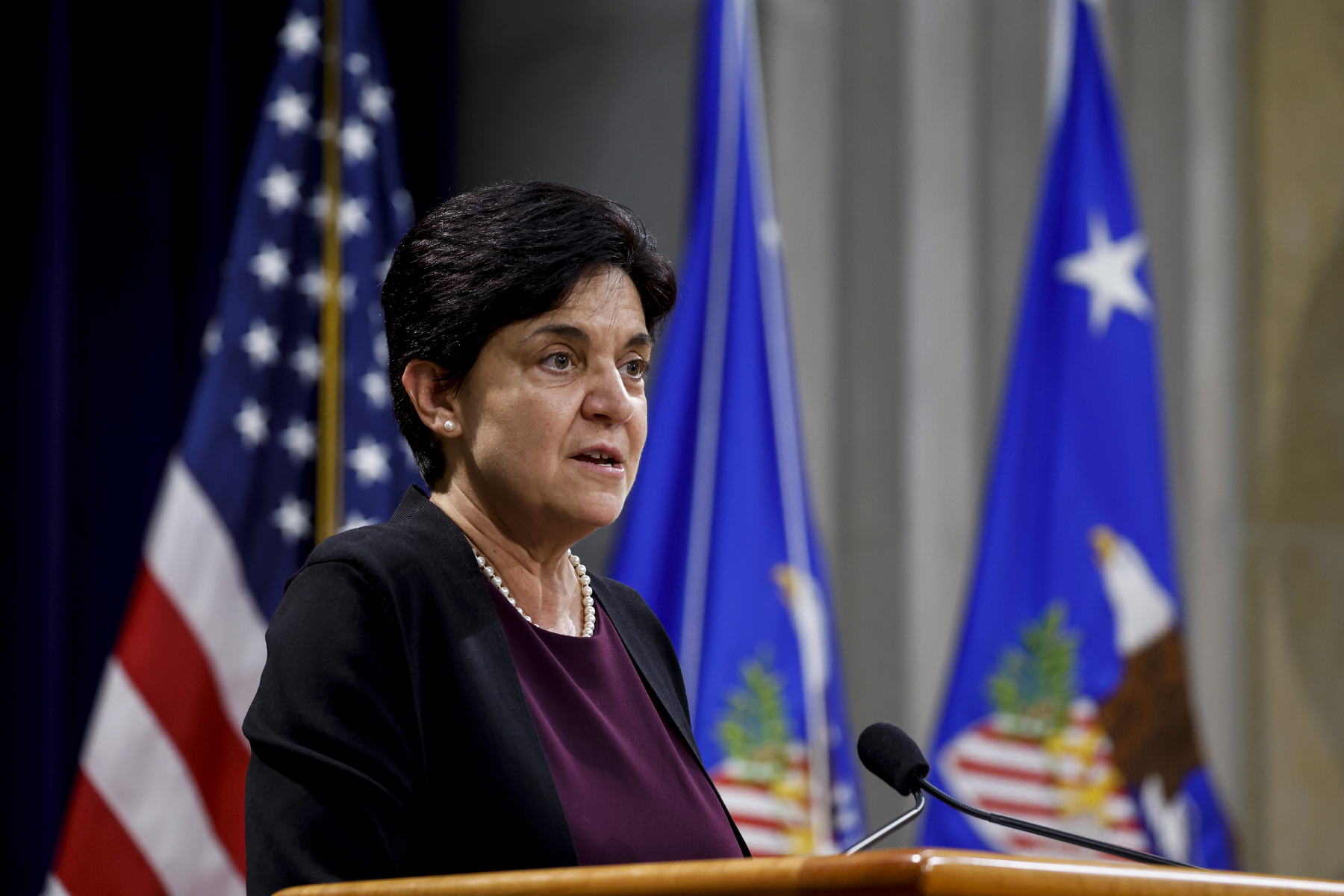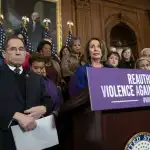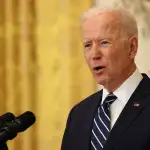Rosie Hidalgo was sworn in as the newest director of the Office of Violence Against Women (OVW) in July, overseeing the office’s $700 million budget to fund programs to prevent gender-based violence and to support survivors. Hidalgo comes to the post after a 30-year-long career as an attorney, advocate, and most recently as a special assistant to President Joe Biden on gender-based violence.
She is also the former senior director of public policy for Casa de Esperanza: National Latin@ Network for Healthy Families and Communities, a national resource center with a focus on providing training, research, and policy advocacy to prevent and end domestic violence and sexual assault.
As National Domestic Violence Awareness Month comes to a close, Hidalgo spoke with The 19th about how she views this work, its success, and what it means to bring about holistic cultural change through community collaboration and government.
This interview has been lightly edited for length and clarity.
Jennifer Gerson: How would you explain the work that the Office of Violence Against Women does and how it translates into a felt impact for Americans?
Rosie Hidalgo: The Office of Violence Against Women is tasked with overseeing the implementation of the Violence Against Women Act (VAWA), a critical and vital piece of federal legislation that passed in 1994. It represents a national commitment to coming together in a more comprehensive fashion seeking to prevent and end domestic violence (DV), dating violence, sexual assault and stalking.
One of the hallmarks of VAWA is trying to support what we call a coordinated community response, to make sure that survivors have pathways to safety, to justice, to healing, to support from wherever they seek services — whether that’s a victim service organization, whether it’s through law enforcement, whether it’s on a college campus, whether it’s through health care. What this does is, over time, put money into states and territories that really help identify and lift up promising practices.
When you think about the relationship between gun violence and gender-based violence, what do you think needs the most attention right now, especially in communities that have seen levels of gun violence rising?
An important aspect of this work is making sure that we continue to research: What are the risk factors?
OVW and VAWA funds a national resource center on the intersection of DV and firearms, going back probably at least 10 years, really helping lift up promising practices. We have been funding some pilot projects in jurisdictions around the country about how to best support survivors. Most recently, I had an opportunity to visit Oklahoma City’s branch of Operation 922, where the U.S. attorney’s office is working closely with local prosecutors and also the Family Justice Center. At OVW, we’re trying to not only reduce DV homicides, but also address the high levels of threats and coercion and other things that undermine the safety and stability of survivors.
From where you sit, who are we not talking about enough and who are you concerned we are not reaching enough when it comes to these kinds of support services? What will it mean to identify these demographics and best figure out how to reach them?
I think there’s a misconception that because it’s called the Violence Against Women Act that people think it exclusively focuses on women. It’s called VAWA because it recognizes the way that women and girls are disproportionately impacted by these forms of gender-based violence, but the act itself is actually gender neutral. The goal is to reach any and every survivor regardless of gender identity, sexual orientation, race, ethnicity, immigration status, age or disability.
What’s really important about VAWA is that it seeks to put resources into the hands of those communities and community-based organizations that already have buy-in from certain individuals — those with disabilities, those in rural communities, individuals from communities of color and LGBTQ+ individuals.
But some people may want to engage with the criminal justice system, too, so we are very much also thinking about how we are training law enforcement, prosecutors and the courts to be trauma-informed and to reduce barriers of access to survivors from a range of communities, while also recognizing that there are others who may seek services and support outside of legal systems and to make sure in particular that we’re funding those kinds of projects.
Like you just said, many people who seek help and support after experiencing gender-based violence do so outside of the legal system. Given that, how do you measure success and what success means in this work?
Some people think that success is only measured by prevalence data, but there’s a lot more that goes into how we are making sure that an individual is getting the comprehensive support they need over time, which is what we have seen is so crucial. People need economic security, housing stability, services that focus not only on safety but healing. And these are all things that are very long-term.
Initially in this field, people really focused on DV shelters, which are still very important. But over time we realized that was a very limited approach. Now, we are heavily focused on putting funds into transitional housing grants, grants that are up to two years long. That’s an opportunity for a survivor and their children to get the kind of longer term support they need to see to put them on the pathway to not just go from being a victim to being a survivor, but to move into thriving.
But success is also prevention. On college campuses, we are funding initiatives focused on engaging men and boys as allies, realizing that sometimes those are aspects of success that are harder to quantify but that are also really critical.
While we are trying to improve access to social services, ultimately what we’re really working on is social transformation. We’re working on changing norms so that there is no tolerance for abuse. So part of that success is how are we helping friends, family, classmates and coworkers see themselves in this work? Sometimes people feel like, “Oh we just call 911” or, “We help someone go to a shelter,” but they don’t realize that it really involves all of us as a community in terms of not only prevention but response.
For me, how we measure success in the long term [is] raising awareness in broadening the types of coordinated community responses and bringing more people to the table to be a part of that effort.
Given this, how do you think we start to make really meaningful steps in this larger, holistic cultural shift that you describe, that ultimately reduces the need to do the social support services side of this work?
I think we have seen over time an increase in the national consciousness of the reality that there cannot be any tolerance for domestic violence, sexual assault or stalking. President Biden talks a lot about this from his own experience when he was helping as one of the lead authors and champions of VAWA in the Senate back in ‘94. He always talks about how there was a time when people would say, “No, this is a private family matter. Nobody should be talking about this in public, nor is there a need for government involvement.”
It’s also very important that for each reauthorization of VAWA that we keep it bipartisan. This is about saying you are for healthy families, that you are for healthy communities that are environments where children can thrive. We see all the adverse childhood experience studies that have demonstrated the detrimental long-term effects for kids who are exposed to violence in the home. I think there is a wider growing recognition that everyone has a role to play here.
How do we create cultural change and what role do you see the Biden administration having in that?
Ultimately, we need to just continue to set that vision of moving toward a society where this is very rare. We still have further to go, but that’s one of the reasons why we are glad that through this administration and through the support of Congress, the most recent reauthorization of VAWA has seen an appropriation of $700 million. That’s about a 35 percent increase over the last few years.
We are also working across the administration; strengthening the work that other federal agencies can do that is so critical. For example, HUD [the Department of Housing and Urban Development] through the last VAWA authorization created a new office within the agency on preventing and addressing gender-based violence. The administration also created a new position at HHS [the Department of Health and Human Services] at a senior level, looking at issues of sexual violence and preventing gender-based violence.
The VA [Department of Veterans Affairs], the Department of Education, the Department of Labor, the military — they all have an important role to play. I like to say that it is easier sometimes to all do our own work in our silos, but survivors’ lives don’t exist in silos. So we all need to figure out whether it’s at the local level or at the federal or at the state level how to continue to have better coordination and collaboration to more historically address gender-based violence. In my 30 years of doing this work, I have seen significant progress. We certainly have much further to go, but knowing that is what keeps me hopeful.







